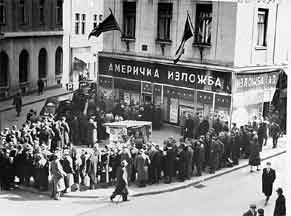Civil war broke out in Yugoslavia. As the Communist regime fell, Yugoslavia was divided up into Serbia, Bosnia-Hergezovenia, Macedonia, Croatia and Slovenia. Fighting soon broke out inside these areas, as Serbs attempted to gain control of the entire territory. The Serbs instituted a policy of "ethnic" cleansing, whose goal was to force non-Serbs out of all areas that the Serbs conquered. .
Yugoslavia was a multi-ethnic federation of six republics - Serbia, Croatia, Slovenia, Bosnia-Herzegovina, Montenegro, and Macedonia - and two autonomous provinces within Serbia, Kosovo and Vojvodina. The country was held together by the strong hand of Josip Broz Tito, who ruled as its communist leader from the end of World War II until his death in 1980. However, Tito's death and the subsequent decline of communism in Eastern Europe exposed the underlying tensions between the various nationalities that made up Yugoslavia.
In the late 1980s and early 1990s, nationalist sentiments began to rise, fueled by economic stagnation, political unrest, and the growing influence of nationalist politicians like Slobodan Milosevic in Serbia. The weakening of the communist regime and the rise of nationalism led to a series of events that ultimately fractured the federation. Slovenia and Croatia declared independence in June 1991, followed by Macedonia in September 1991 and Bosnia-Herzegovina in March 1992.
The declarations of independence by the various Yugoslav republics led to the outbreak of armed conflicts, as ethnic Serbs, who constituted a significant minority in these regions, sought to maintain control over the territories they considered their historical homeland. The Yugoslav People's Army (JNA), which was predominantly composed of ethnic Serbs and controlled by Serbia, intervened in support of the Serb populations in these regions.
The first major conflict erupted in Croatia, as the JNA and local Serb forces sought to establish a Serb-dominated enclave known as the Republic of Serbian Krajina. The war in Croatia was marked by fierce fighting, mass displacement of civilians, and numerous atrocities committed by both sides.
The situation in Bosnia-Herzegovina was even more complex, as the republic was home to a diverse population of Bosniak Muslims, Croats, and Serbs. As the Bosnian government declared independence, Bosnian Serbs, supported by Serbia and the remnants of the JNA, embarked on a campaign to create a Serb-dominated entity within Bosnia-Herzegovina, known as Republika Srpska.
The wars in Croatia and Bosnia-Herzegovina were characterized by a brutal policy of "ethnic cleansing" perpetrated by the Serb forces. Ethnic cleansing refers to the systematic expulsion, displacement, or even extermination of an ethnic or religious group from a specific territory. The goal of this policy was to create ethnically homogeneous territories under Serb control.
The Serb forces conducted mass expulsions, forced migrations, and large-scale massacres of non-Serb populations, particularly Bosniak Muslims in Bosnia-Herzegovina. Some of the most notorious instances of ethnic cleansing occurred in the Bosnian towns of Srebrenica and Prijedor, where thousands of civilians were systematically murdered, and in the concentration camps established by the Serbs to detain and torture non-Serbs.
 >
>